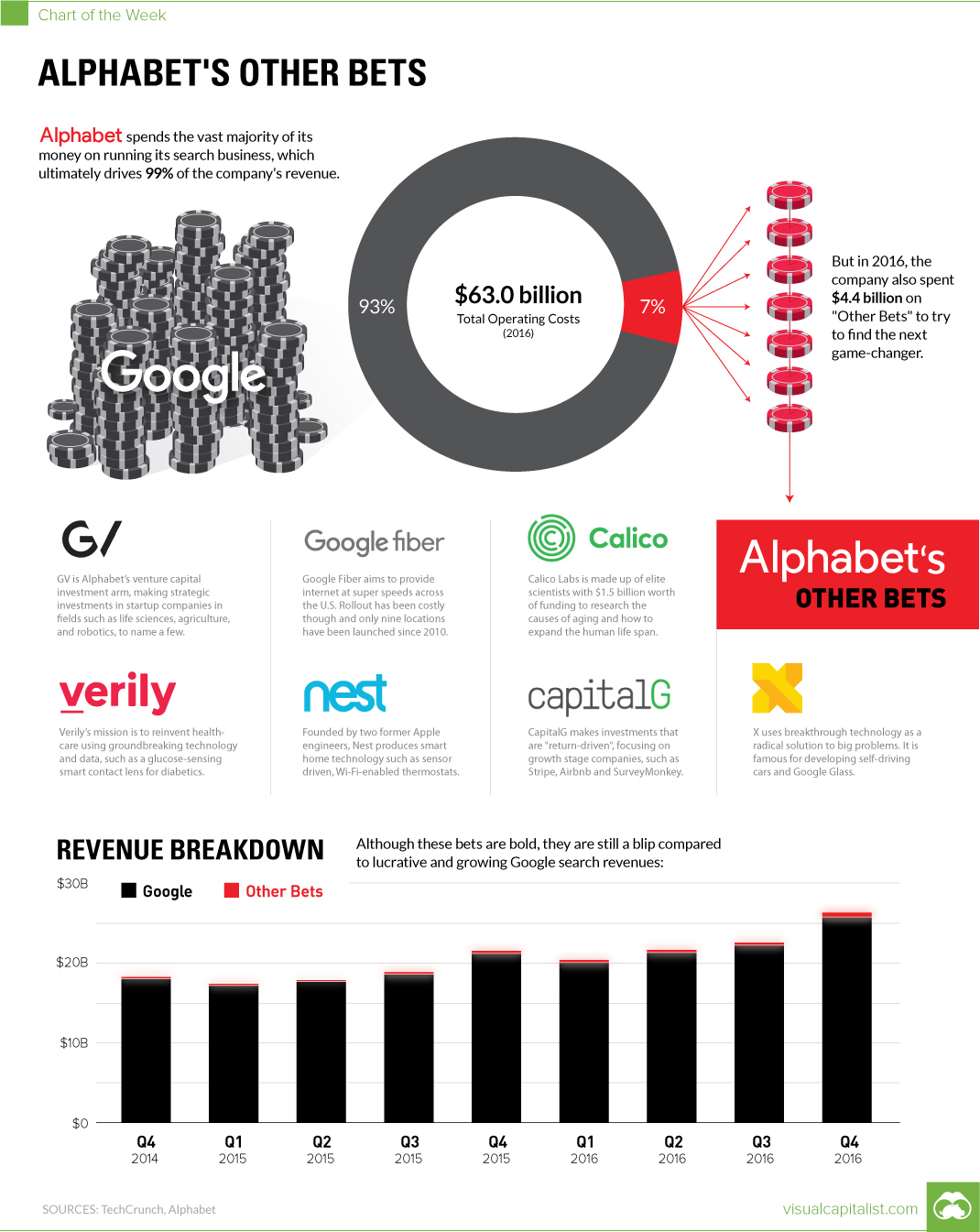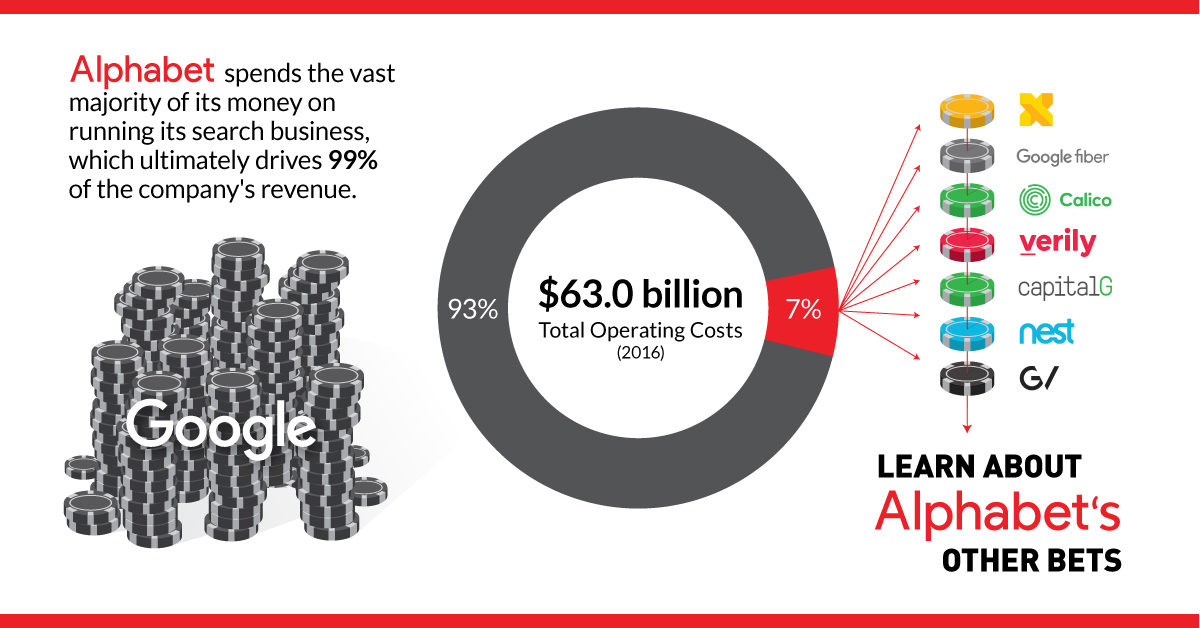Technology
Chart: Vetting Alphabet’s $4 Billion in “Other Bets”

Chart: Vetting Alphabet’s $4 Billion in “Other Bets”
The Chart of the Week is a weekly Visual Capitalist feature on Fridays.
Regardless of whether the policy remains in place today, one of Google’s most famous management philosophies has been the “20% rule”. Legend goes that especially in Google’s earlier days, employees were encouraged to spend 20% of their time working on new initiatives that could potentially benefit Google outside of their regular workflows, teams, and projects. This meant there was time to explore new ideas or to challenge existing status quos within the organization.
It’s a seemingly arbitrary and systematic way to spur innovation, but it has worked well over the years. The 20% rule has apparently led to new products such as Gmail, Google News, and AdSense, which are all important aspects of Google’s business today.
It should not be surprising then, that Google’s parent company Alphabet also takes a systematic approach to innovating outside of its core search business. By making ambitious “Other Bets” and keeping investors up-to-date with their own segment on the company’s financial statements, Alphabet shows both commitment and discipline in finding its next multi-billion dollar game-changer.
“Other Bets”
In 2016, Alphabet was a cash machine. The company raked in $19.5 billion of profit off of a whopping $87.4 billion of revenue.
The only challenge? If you do the math, 99% of that revenue comes from Google, which currently dominates digital advertising with a 41% share of the entire market.
Wisely, the company does not want to put all of its eggs in one basket – and it spends about 7% of its annual operating costs on facilitating “Other Bets”. Here is what else Alphabet is up to:
Google Fiber
Google Fiber aims to provide internet at super speeds across the United States. Rollout has been costly though and only nine locations have been launched since 2010.
Calico Labs
Calico Labs is made up of elite scientists with $1.5 billion worth of funding to research the causes of aging and how to expand the human life span.
Nest
Founded by two former Apple engineers, Nest produces smart-home technology such as sensor-driven, Wi-Fi-enabled thermostats.
Verily
Verily’s mission is to reinvent healthcare using groundbreaking technology and data, such as a glucose-sensing smart contact lens for diabetics.
GV
GV, formerly known as Google Ventures, is Alphabet’s venture capital investment arm, making strategic investments in startup companies in fields such as life sciences, agriculture, and robotics, to name a few.
CapitalG
CapitalG makes investments that are “return-driven”, focusing on growth stage companies, such as Stripe, Airbnb and SurveyMonkey.
X
X uses breakthrough technology as a radical solution to big problems. Its most famous projects are its self-driving car and Google Glass.
Which “Other Bets” are Paying Off?
“Other Bets” generated $809 million in revenue in 2016, which is a 82% increase over 2015. This revenue came mostly from Nest, Fiber, and Verily.
Nest, which aims to dominate the smart home of tomorrow, was acquired for $3.2 billion in 2014. And while it does generate revenue for Alphabet, it has been viewed mostly as a disappointment even from the company’s perspective.
Verily is Alphabet’s business in life sciences, and is apparently profitable already. The unit partners with pharmaceutical companies to make money, and it will also eventually move forward with human clinical trials on its smart contact lens product.
Lastly, Fiber has been rolled out in nine cities across the United States to provide ultra-fast broadband speeds for internet and television. In recent news, Fiber has laid off employees, while halting many further expansion plans.
Technology
Visualizing AI Patents by Country
See which countries have been granted the most AI patents each year, from 2012 to 2022.

Visualizing AI Patents by Country
This was originally posted on our Voronoi app. Download the app for free on iOS or Android and discover incredible data-driven charts from a variety of trusted sources.
This infographic shows the number of AI-related patents granted each year from 2010 to 2022 (latest data available). These figures come from the Center for Security and Emerging Technology (CSET), accessed via Stanford University’s 2024 AI Index Report.
From this data, we can see that China first overtook the U.S. in 2013. Since then, the country has seen enormous growth in the number of AI patents granted each year.
| Year | China | EU and UK | U.S. | RoW | Global Total |
|---|---|---|---|---|---|
| 2010 | 307 | 137 | 984 | 571 | 1,999 |
| 2011 | 516 | 129 | 980 | 581 | 2,206 |
| 2012 | 926 | 112 | 950 | 660 | 2,648 |
| 2013 | 1,035 | 91 | 970 | 627 | 2,723 |
| 2014 | 1,278 | 97 | 1,078 | 667 | 3,120 |
| 2015 | 1,721 | 110 | 1,135 | 539 | 3,505 |
| 2016 | 1,621 | 128 | 1,298 | 714 | 3,761 |
| 2017 | 2,428 | 144 | 1,489 | 1,075 | 5,136 |
| 2018 | 4,741 | 155 | 1,674 | 1,574 | 8,144 |
| 2019 | 9,530 | 322 | 3,211 | 2,720 | 15,783 |
| 2020 | 13,071 | 406 | 5,441 | 4,455 | 23,373 |
| 2021 | 21,907 | 623 | 8,219 | 7,519 | 38,268 |
| 2022 | 35,315 | 1,173 | 12,077 | 13,699 | 62,264 |
In 2022, China was granted more patents than every other country combined.
While this suggests that the country is very active in researching the field of artificial intelligence, it doesn’t necessarily mean that China is the farthest in terms of capability.
Key Facts About AI Patents
According to CSET, AI patents relate to mathematical relationships and algorithms, which are considered abstract ideas under patent law. They can also have different meaning, depending on where they are filed.
In the U.S., AI patenting is concentrated amongst large companies including IBM, Microsoft, and Google. On the other hand, AI patenting in China is more distributed across government organizations, universities, and tech firms (e.g. Tencent).
In terms of focus area, China’s patents are typically related to computer vision, a field of AI that enables computers and systems to interpret visual data and inputs. Meanwhile America’s efforts are more evenly distributed across research fields.
Learn More About AI From Visual Capitalist
If you want to see more data visualizations on artificial intelligence, check out this graphic that shows which job departments will be impacted by AI the most.
-

 Mining1 week ago
Mining1 week agoGold vs. S&P 500: Which Has Grown More Over Five Years?
-

 Markets2 weeks ago
Markets2 weeks agoRanked: The Most Valuable Housing Markets in America
-

 Money2 weeks ago
Money2 weeks agoWhich States Have the Highest Minimum Wage in America?
-

 AI2 weeks ago
AI2 weeks agoRanked: Semiconductor Companies by Industry Revenue Share
-

 Markets2 weeks ago
Markets2 weeks agoRanked: The World’s Top Flight Routes, by Revenue
-

 Countries2 weeks ago
Countries2 weeks agoPopulation Projections: The World’s 6 Largest Countries in 2075
-

 Markets2 weeks ago
Markets2 weeks agoThe Top 10 States by Real GDP Growth in 2023
-

 Demographics2 weeks ago
Demographics2 weeks agoThe Smallest Gender Wage Gaps in OECD Countries














